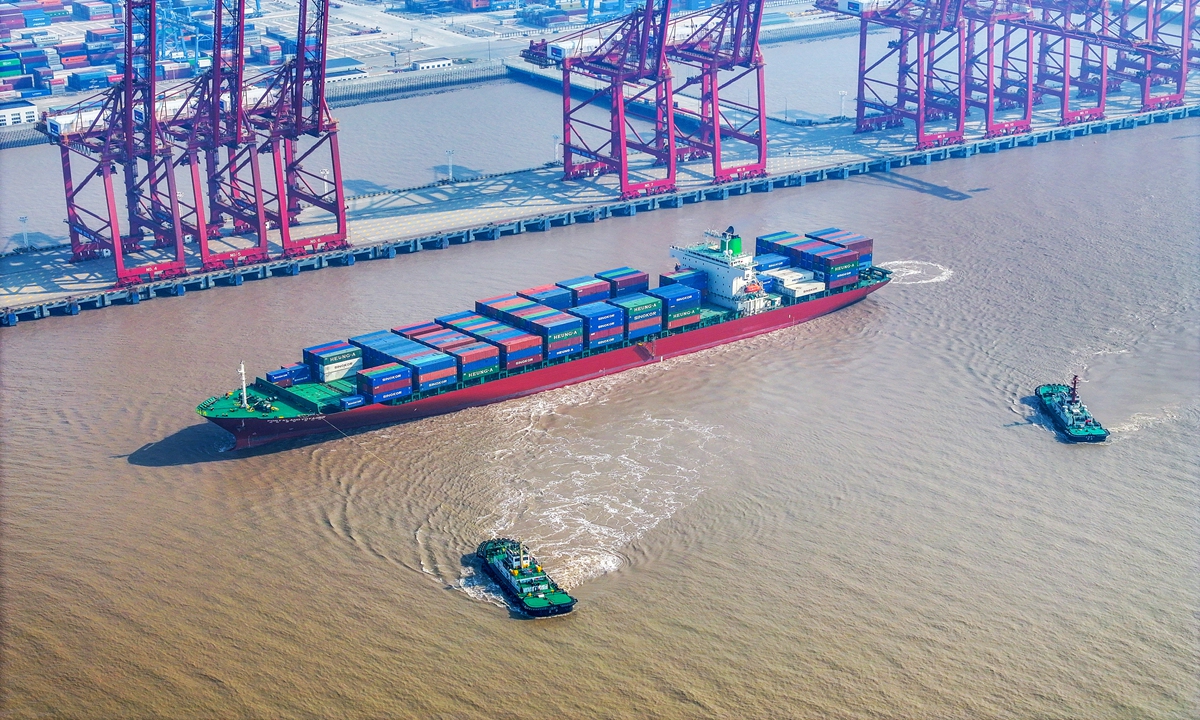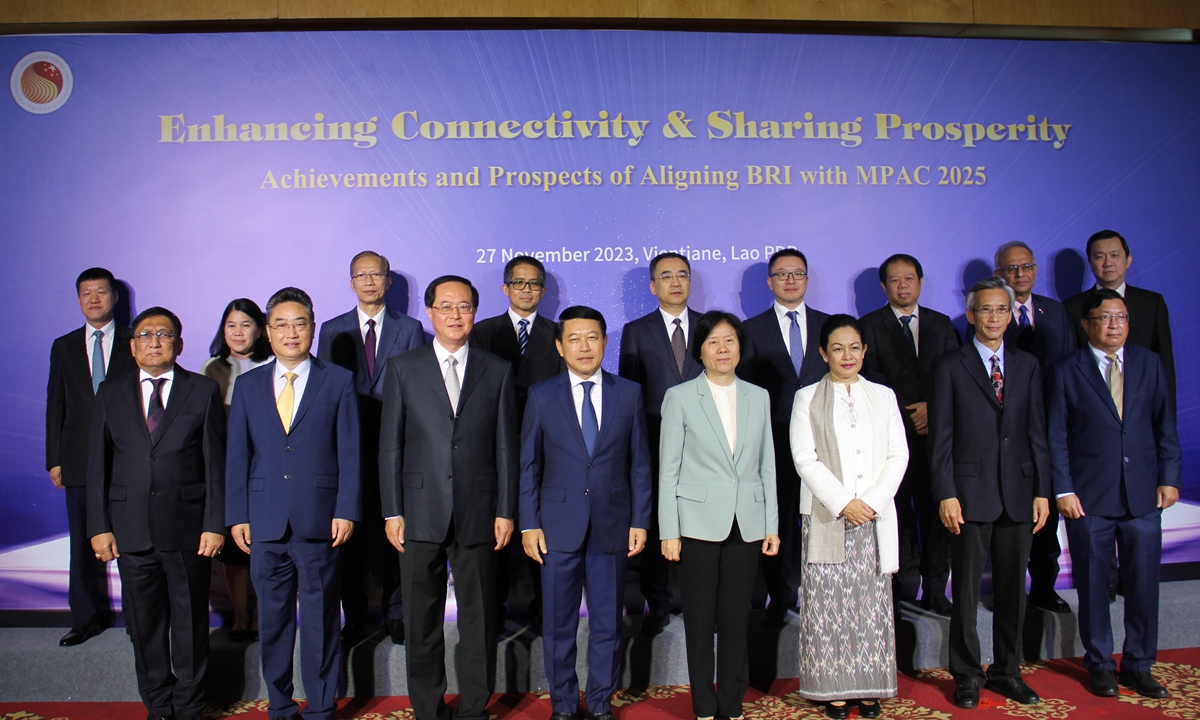BRI empowers localization of industrial chains in China and partner countries
International cooperation in various fields further boosted, integrated

The container ship Port Klang Voyager berths at the Jintang Port in Zhoushan, East China's Zhejiang Province on November 23, 2023. The ship passes through Vietnam, Malaysia, Egypt, Turkey and other BRI partner countries along the coast of Black Sea. Photo: VCG
In a bid to deepen international cooperation in the industrial chain and supply chain, China is hosting the first China International Supply Chain Expo (CISCE) from Tuesday to Saturday in Beijing. This is the world's first national-level exhibition themed on supply chains, which focuses on promoting global industrial chain and supply chain cooperation.
The number of partner countries of China-proposed Belt and Road Initiative (BRI) accounts for nearly half of overseas exhibitors at the CISCE. Overseas exhibitors come from 55 countries and regions, of which nearly 40 countries are BRI partner countries, organizers of the expo told the Global Times.
Many BRI partner countries are in the upstream of international supply chains, providing raw materials and primary products to other countries of the supply chains. BRI partner countries attending the CISCE are looking for industrial and supply chain cooperation with China.
Guo Qingyang, head of China office of Uran Baigal Cashmere, a cashmere product producer headquartered in Ulaanbaatar, Mongolia, told the Global Times that the company is vowing to open the huge market of China with Mongolia's high-quality cashmere, and introduce production equipment from China and seek cooperation with Chinese enterprises in the industrial chain.
Mongolia is the world's second largest reserve of cashmere, making it one of the country's signature export products, Guo said at the CISCE.
"However, the traditional markets for Mongolian cashmere products are Europe, Japan and South Korea, because China is also the world's largest cashmere producer. But we still see a huge market space in Mongolia's participation in the construction of the BRI. That's why we are participating in the CISCE, and we also attended the just-ended 6th China International Import Expo," Guo noted.
This year marks the 10th anniversary of the BRI, which, from a China-proposed initiative to an international practice, has become a well-received international public good and platform for international cooperation.
Chinese companies have carried out a number of industrial investment and cooperation projects in BRI partner countries, covering agriculture, energy, infrastructure, digital economy, new-energy vehicles and other industries, which have strongly promoted the upgrading of industrial structure, as well as the optimization and localization of industrial chains in various countries.
Two-way localization
An example of industrial chain localization is Sinopharm, which has provided more than 3 billion doses of COVID-19 vaccines in 120 countries, regions and international organizations worldwide, Sinopharm told the Global Times.
"We have been cooperating with about 20 countries and regions and boosted the localized production of COVID-19 vaccines," Zhu Jingjin, president of the Biological Products Division at Sinopharm, told the Global Times in an exclusive interview on Tuesday at the venue of CISCE.
Zhu said that during the pandemic, Sinopharm exported the whole industrial chains of vaccine production to several countries, such as Serbia, Morocco and Myanmar, which are BRI partner countries.
"At the beginning, we have to export raw materials but gradually we shifted to local materials. Our technical personnel also helped train local people," Zhu said.
Apart from the efforts of localization by Chinese companies, some foreign companies are also localizing their projects in China.
IEE, a global developer, manufacturer and supplier of advanced sensing solutions headquartered in Luxembourg, established a production base in Langfang, North China's Hebei Province in 2006.
"We import production equipment and high-end raw materials from our European headquarters, and purchase raw materials in China, which are made into products and sold to all over the world," Zhang Liang, market development manager at IEE, told the Global Times, adding that the company came to China, took root in China, and is focused on serving the Chinese market.
With the continuous improvement of production capacity in Langfang, the importance of IEE in the global production system is rising, and products have been widely exported to major automotive markets such as Europe and Asia, Zhang said.
The manager noted that after entering China, IEE continued to promote the localization process. In addition to the production base, it also set up a research and development center.
Luxembourg signed a memorandum of understanding on Belt and Road cooperation with China in 2019.
Unimpeded logistics
Besides of partner countries, beneficiaries of BRI also include those who are enjoying the infrastructure, especially transport infrastructure, completed under the initiative.
Participants of the CISCE stressed that unimpeded logistics brought by BRI is one of the most important factors for smooth and stable international supply chains.
The China-Europe Railway Express, for example, has created a new pattern of international transport between Asia and Europe and has become a "golden channel" for stabilizing the global supply chain. Its rail network has covered 217 cities in 25 European countries, according to official statistics.
Through the China-Europe Railway Express, land transport between Asia and Europe is completely different, Bi Kaida, a senior manager of Rail Freight for Greater China at Scan Global Logistics (SGL), a Danish freight forwarder, told the Global Times on Wednesday at CISCE.
"Sea shipping was the most convenient and economic way to transport goods from China or Asia to Europe before the China-Europe Railway Express started operation. Eurasia land transport, either by train or by truck, would have to go through customs of all passing countries. And in most countries, locomotives need to be replaced, and sometimes trains need to be replaced because the rails are of different widths. It takes time and the procedures are complicated," said Bi.
It takes about 40-50 days to transport goods from Asia to Europe by sea shipping, but it only takes 14-21 days by the China-Europe Railway Express and 10-12 days by trucks. The highways are mostly built in parallel with the railway lines, Bi said.
The company now delivers about 200 containers to Germany and Poland every month through the China-Europe Railway Express. Most of the goods will be then delivered from Germany's Hamburg to Denmark and other Northern Europe countries, according to Bi.
"BRI has greatly promoted the development of inland areas with smooth logistics. In the past, enterprises have to deliver their goods to seaports in the southeastern regions in China, and then transport by ships to global markets. Now, enterprises have more choices," Bi noted.
The building of highways, bridges, high-speed railways, ports, power plants, communication facilities and other infrastructure connects the production, logistics and consumption of different countries and regions together, which is of great significance to the stability and resilience of the global supply chain and the promotion of the integrated development of the global industrial chain, Li Jiqin, executive general manager of CSCEC International, a subsidiary of China State Construction Engineering Corp, said on Tuesday at the CISCE.
So far, China has signed more than 200 documents with 152 countries and 32 international organizations on cooperation under the BRI, covering 83 percent of the countries with which China has established diplomatic relations, according to official statistics.




